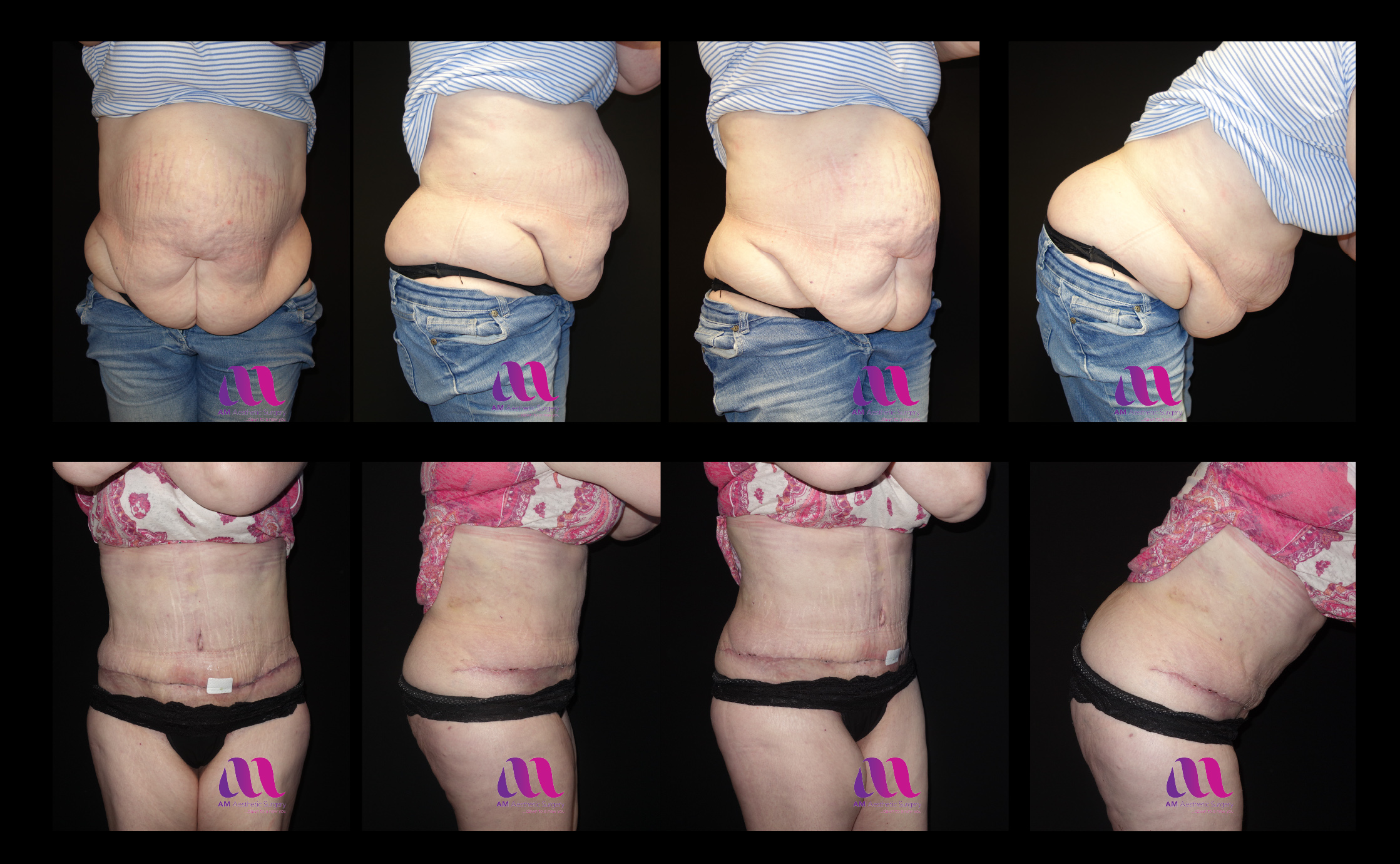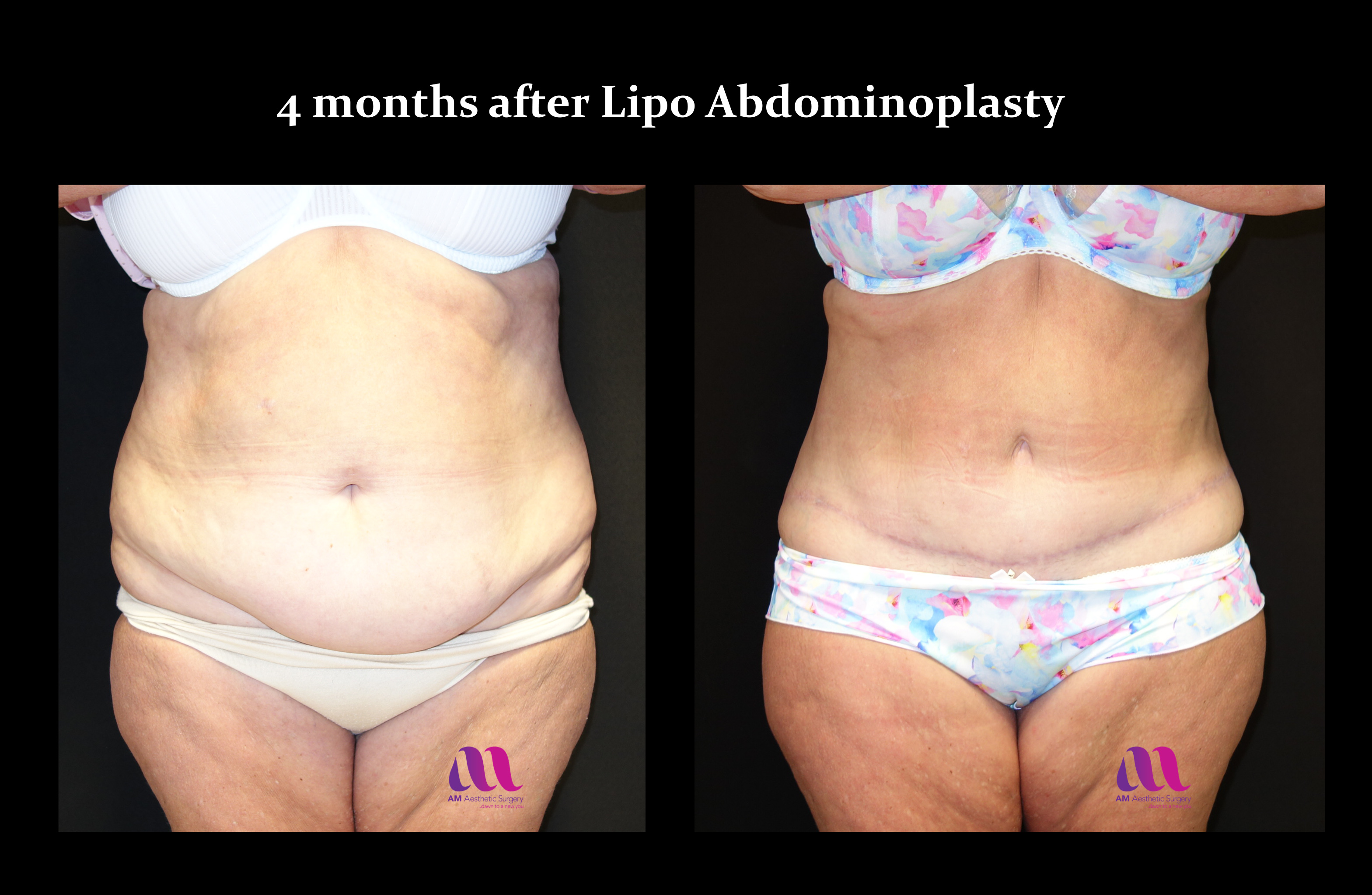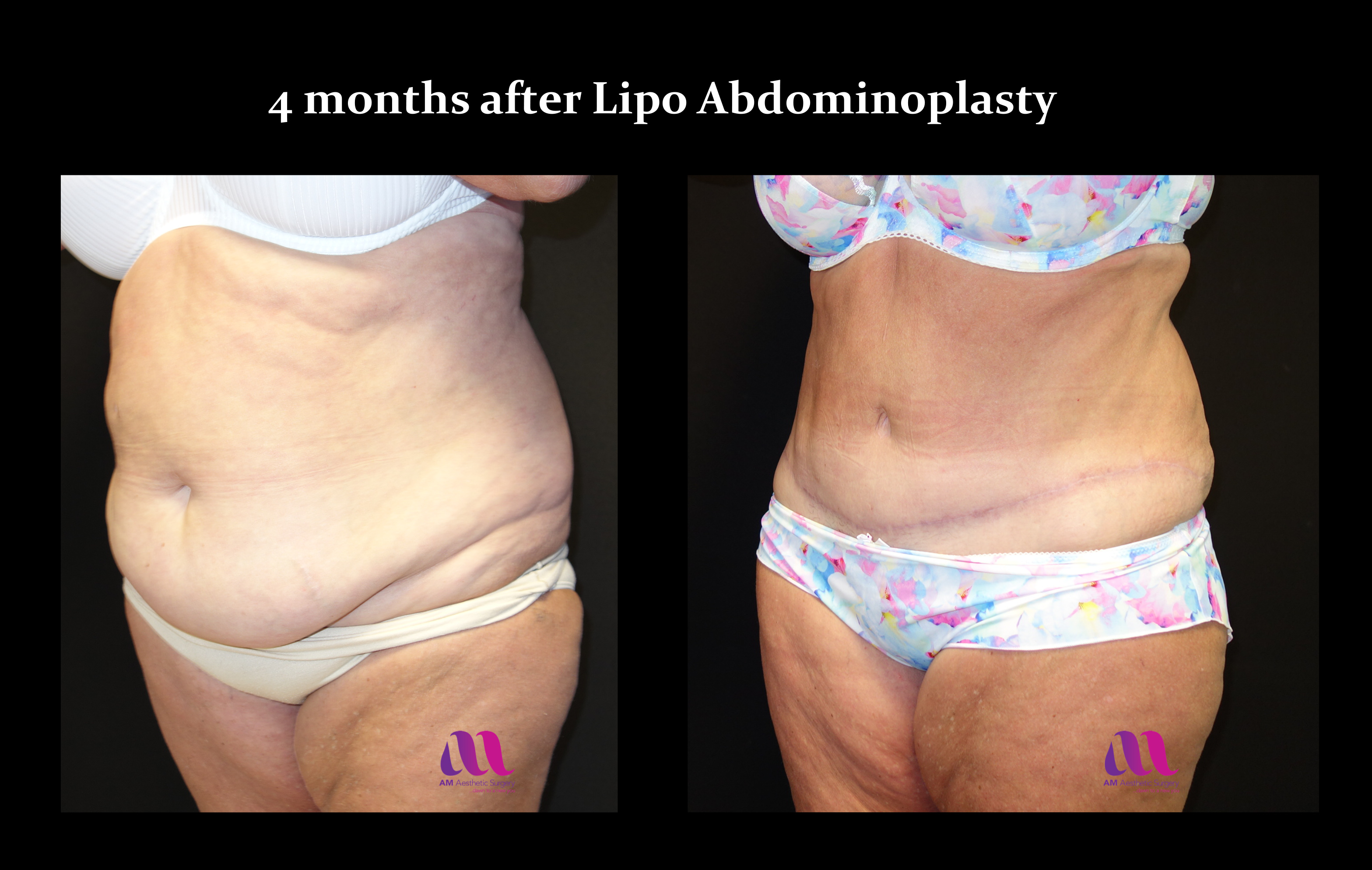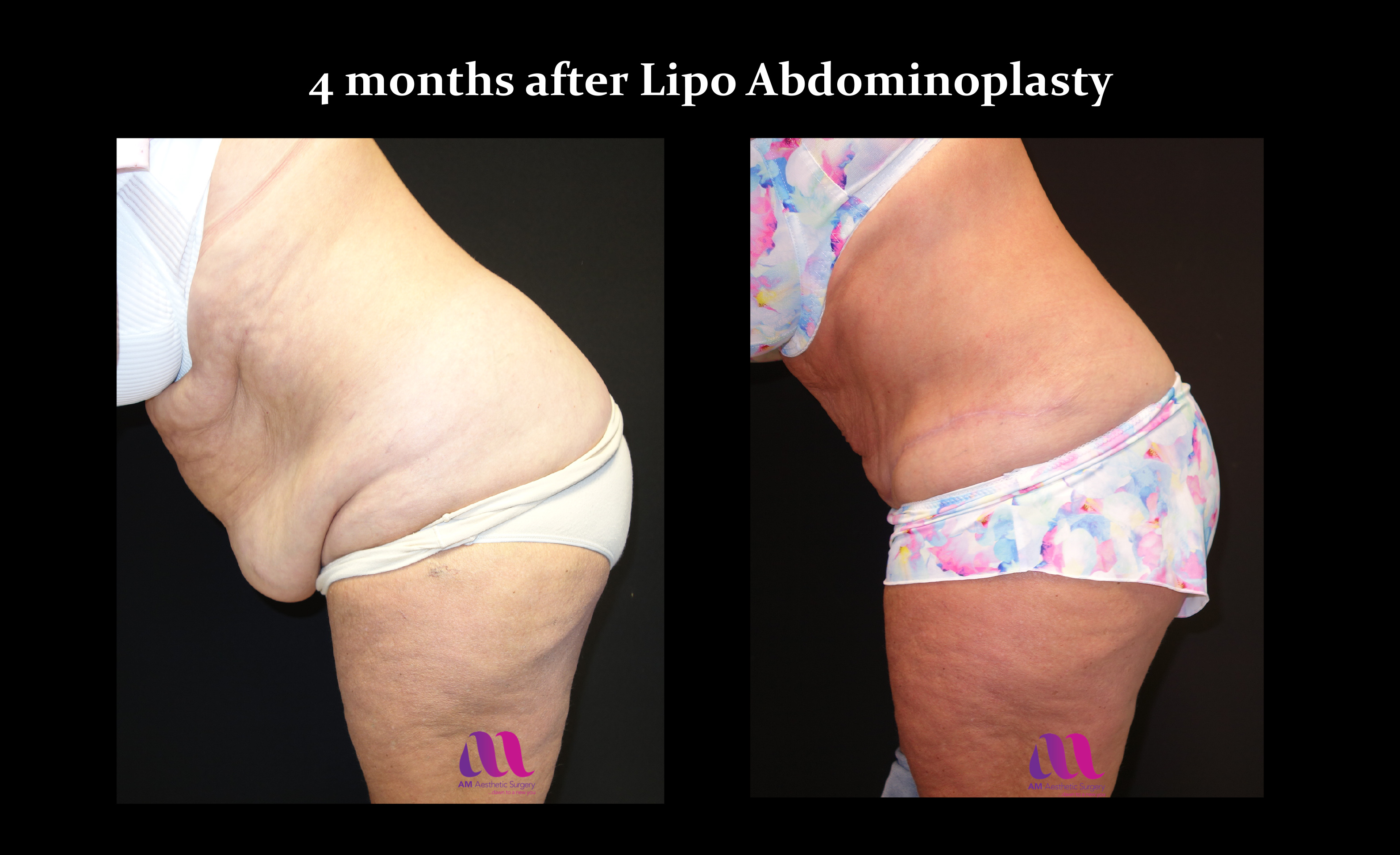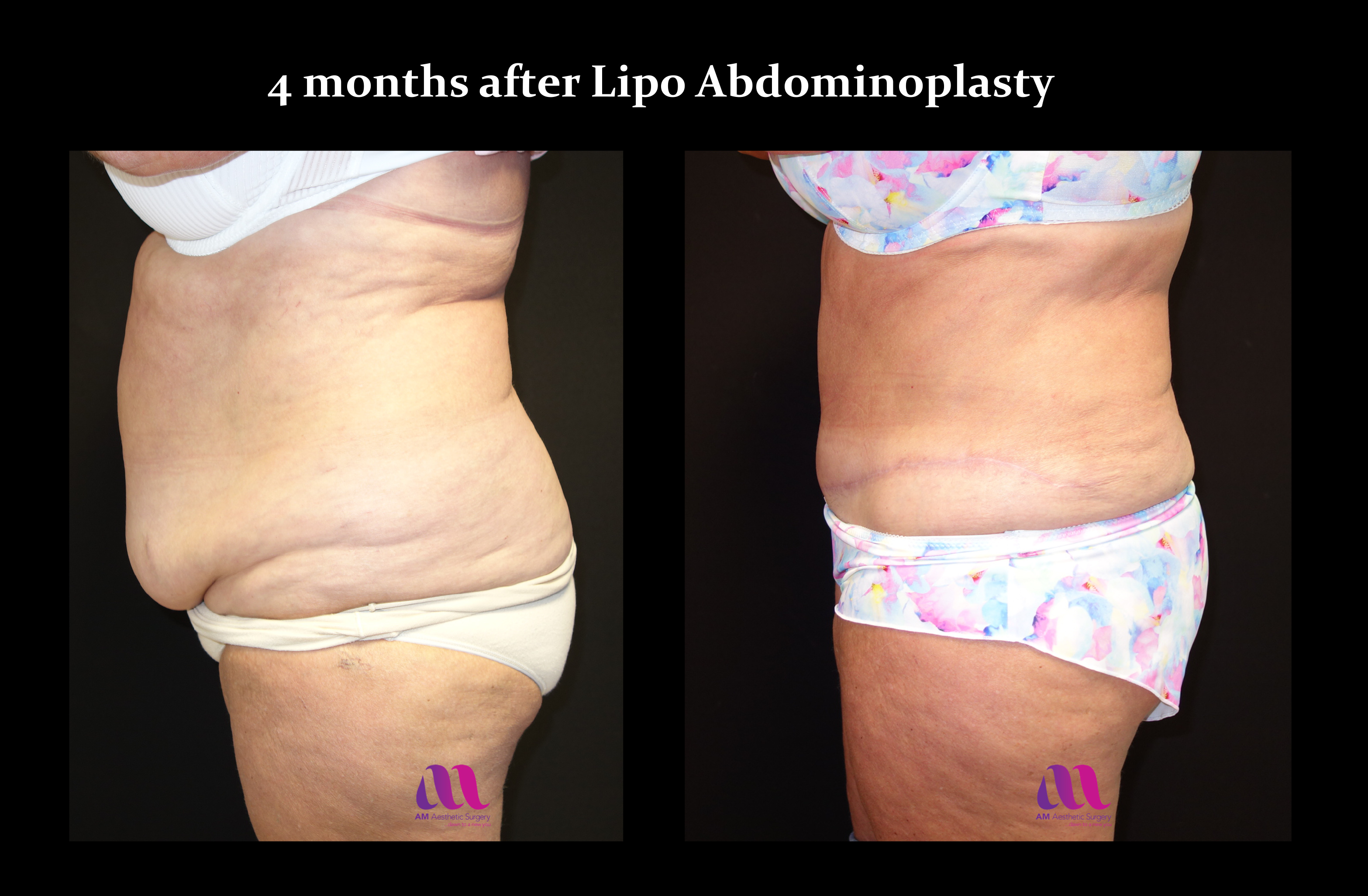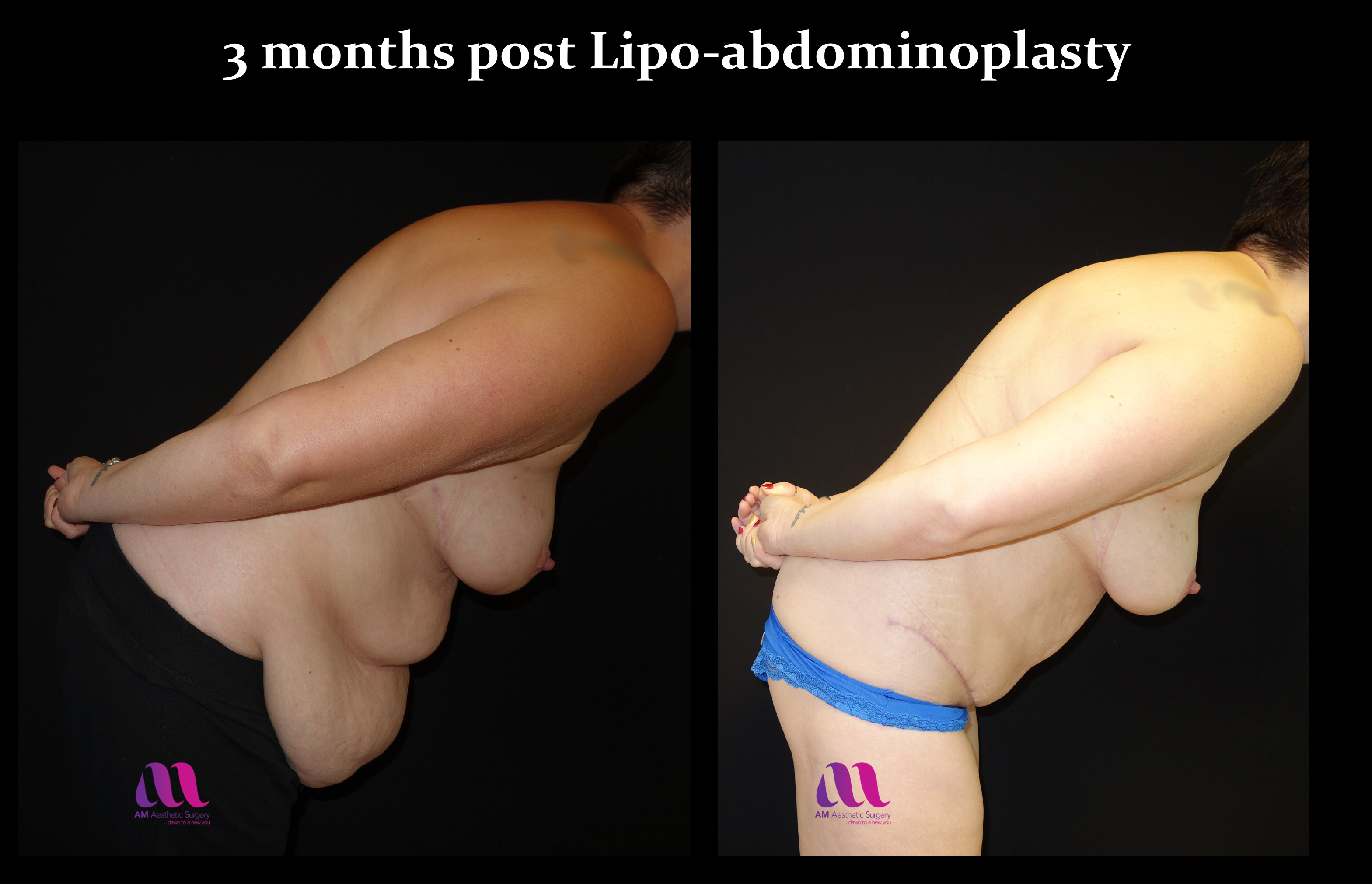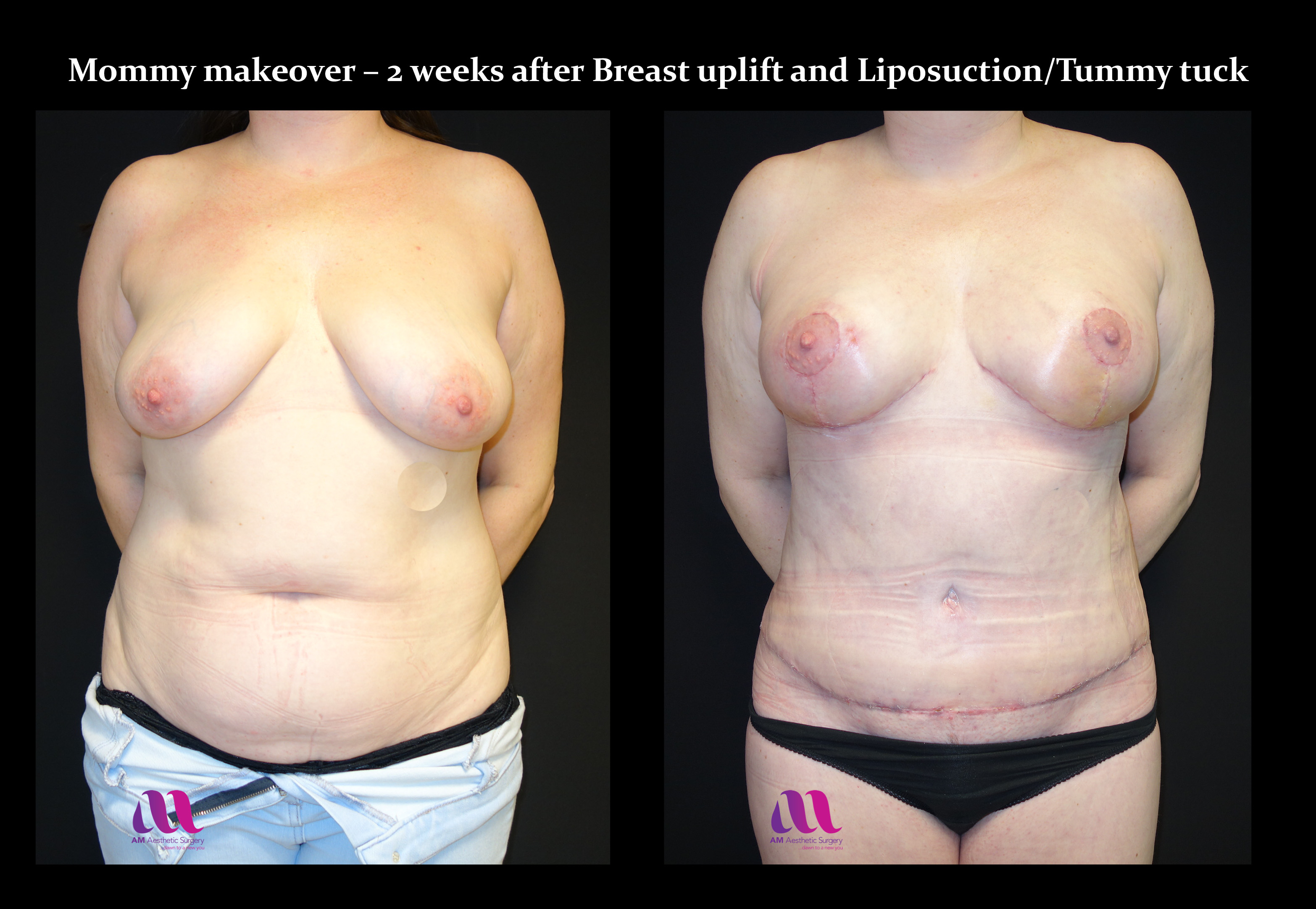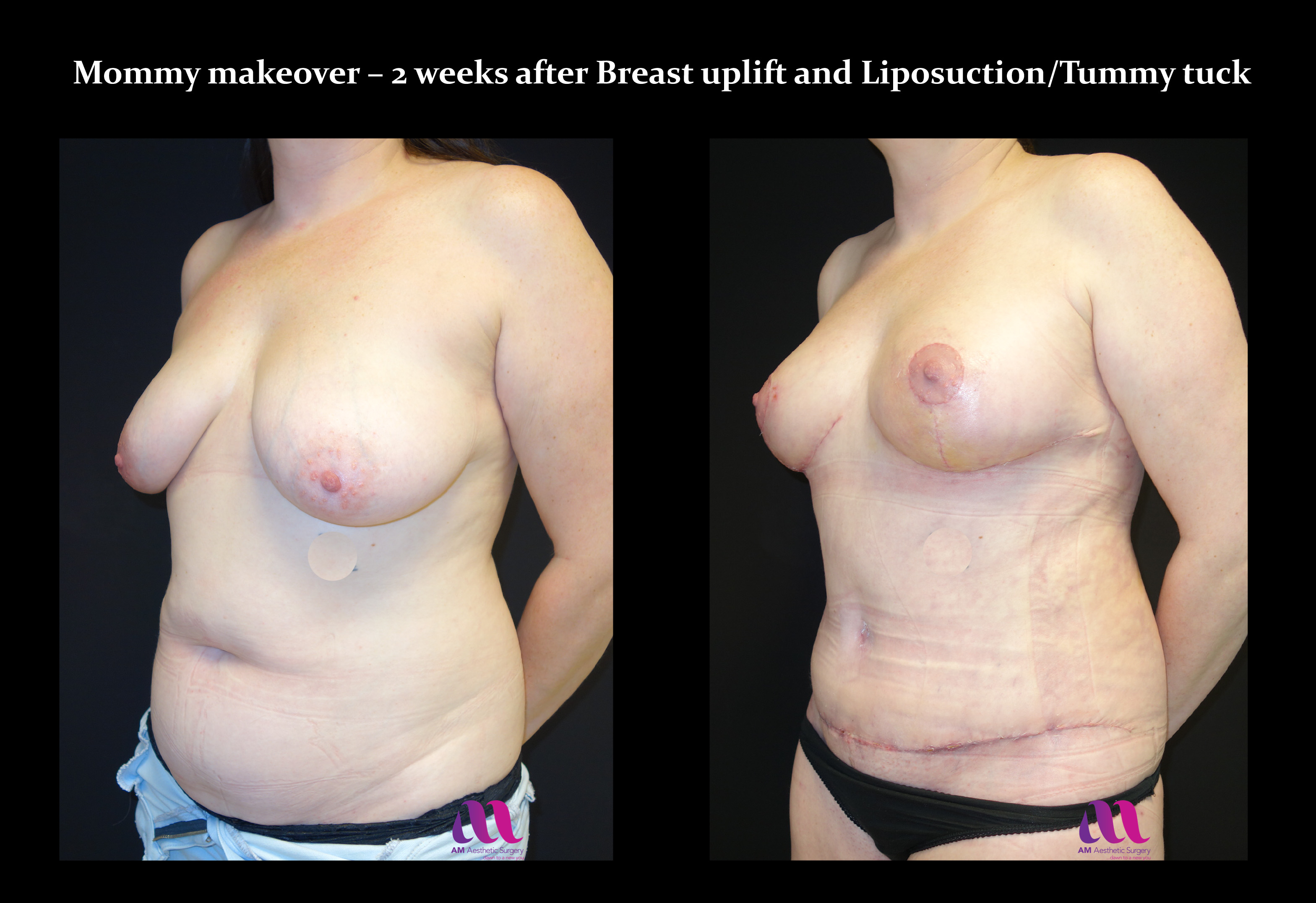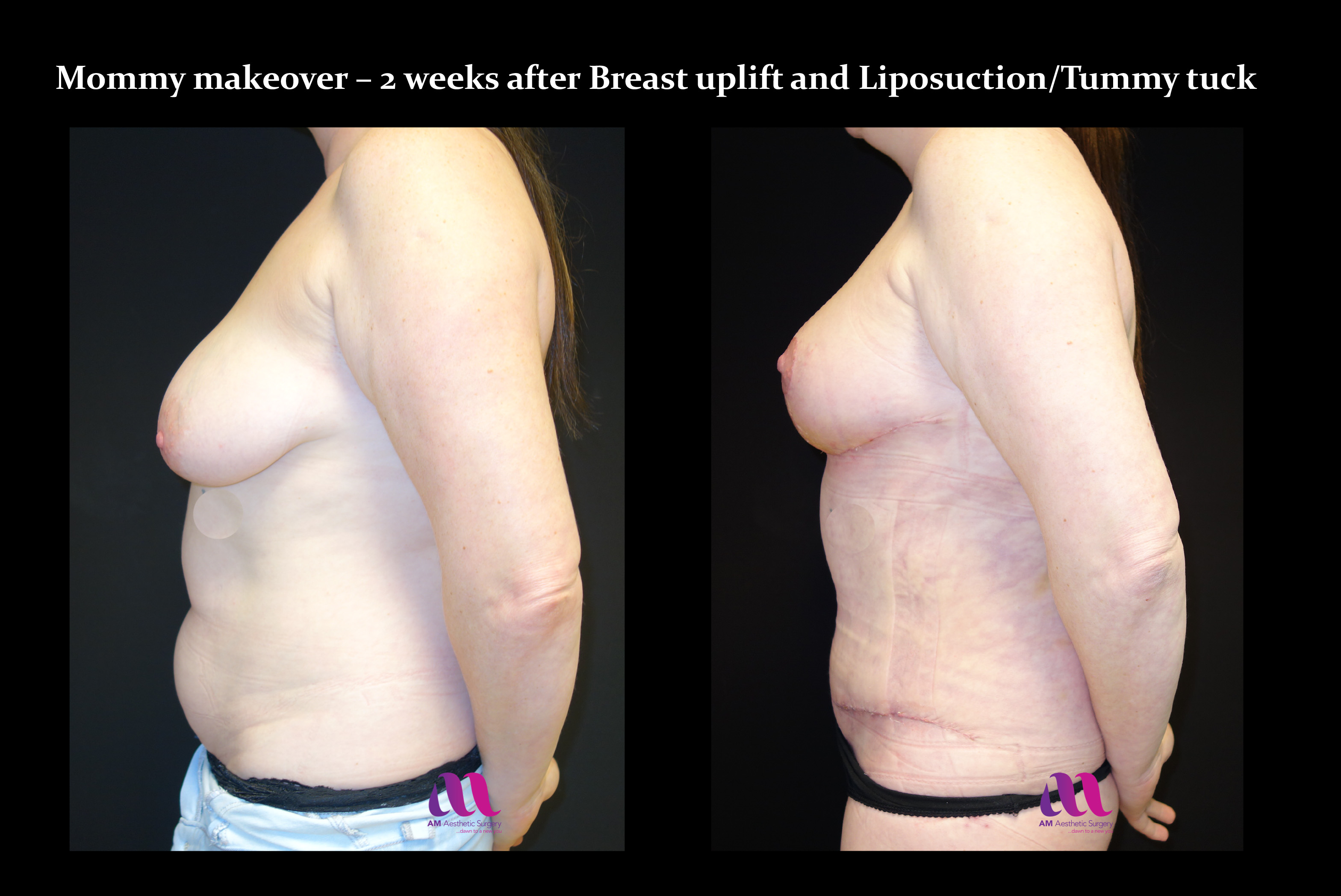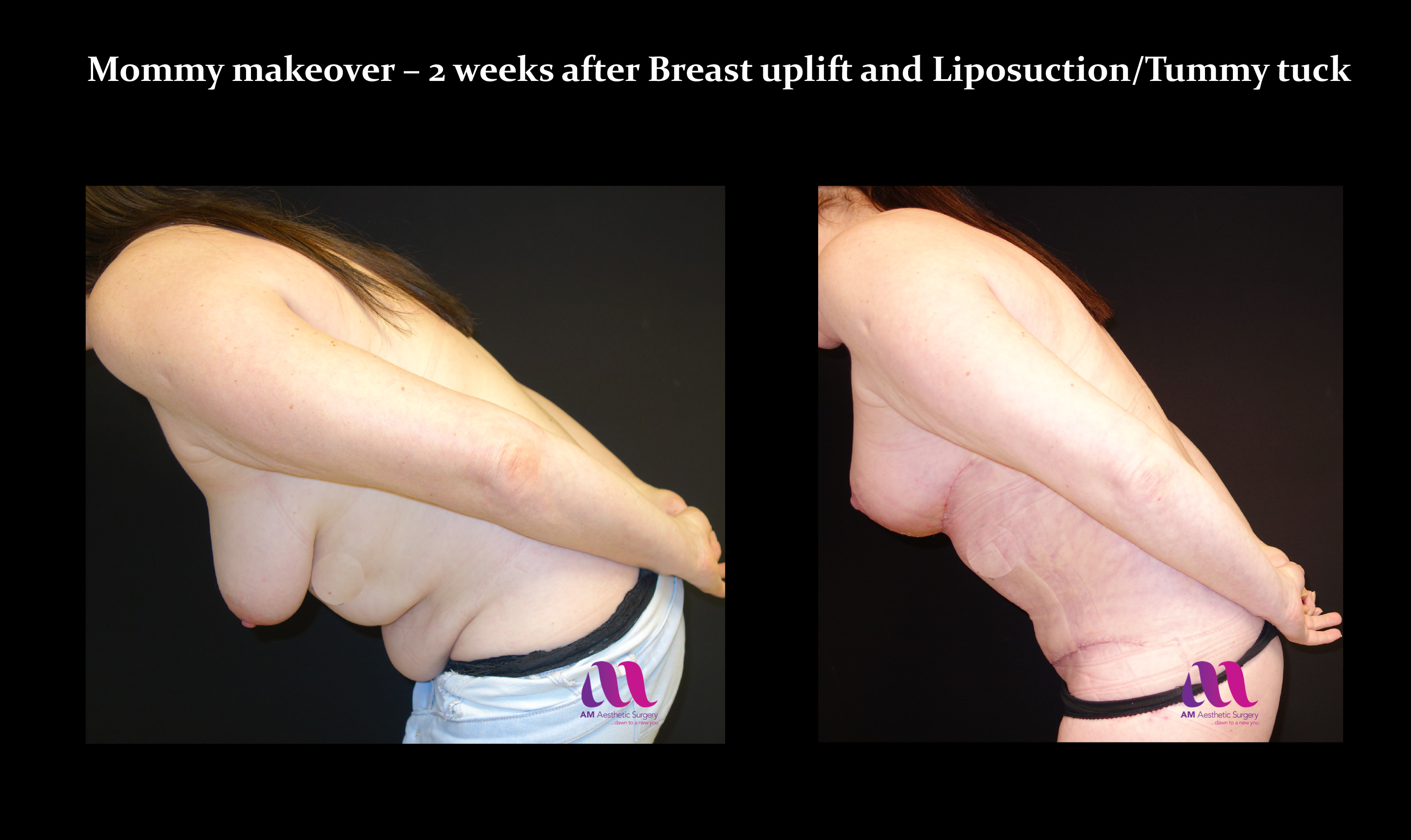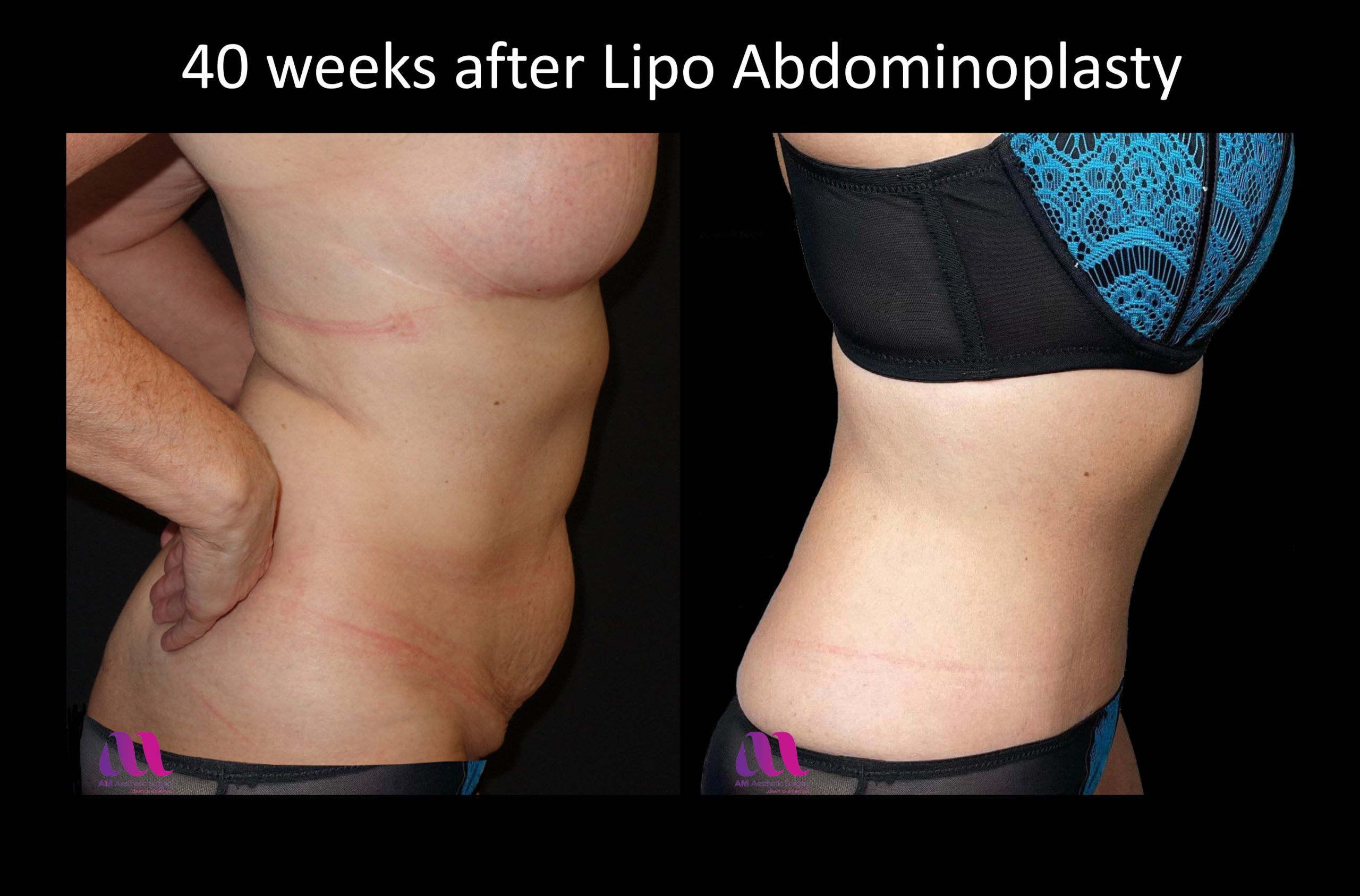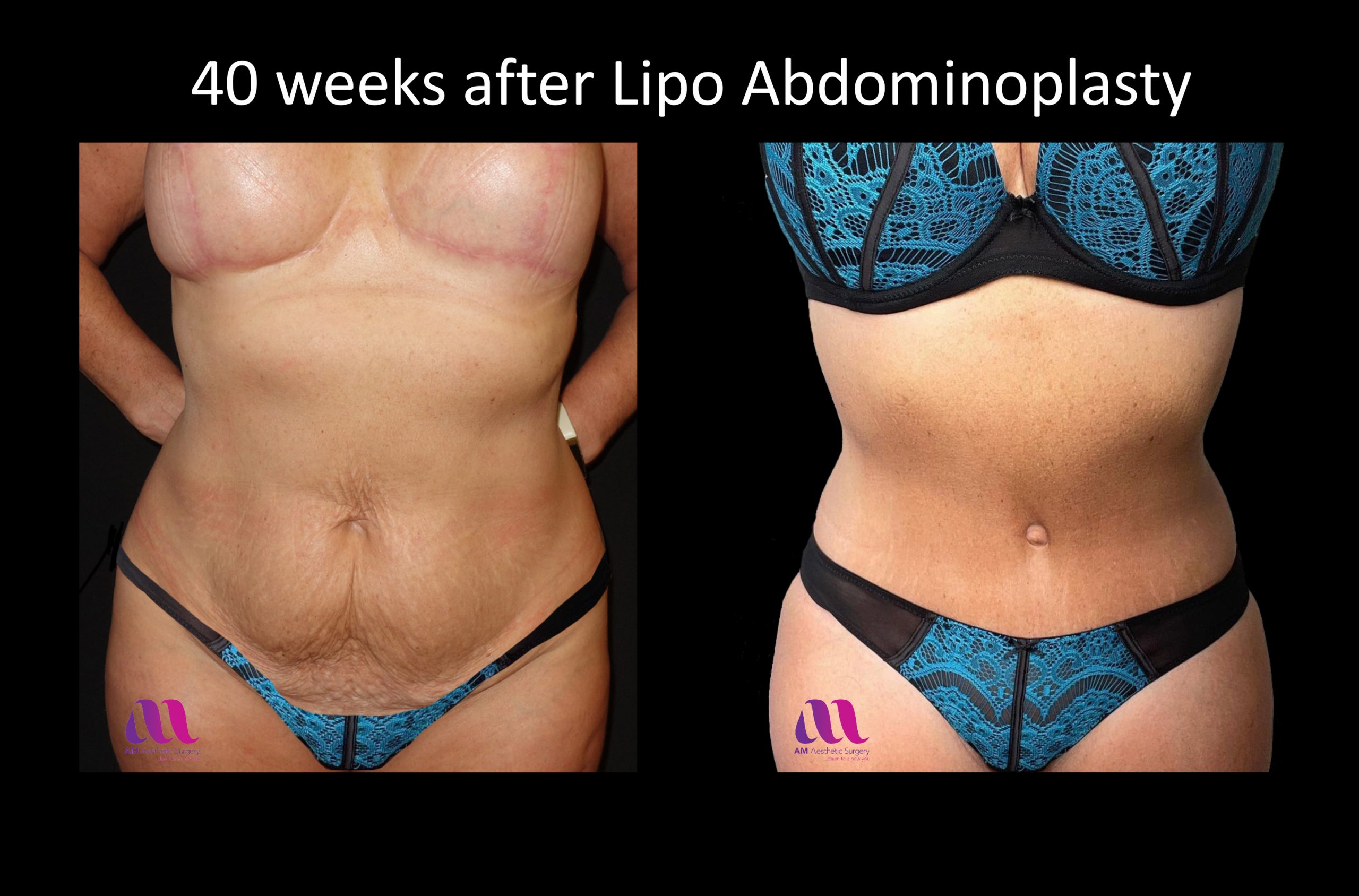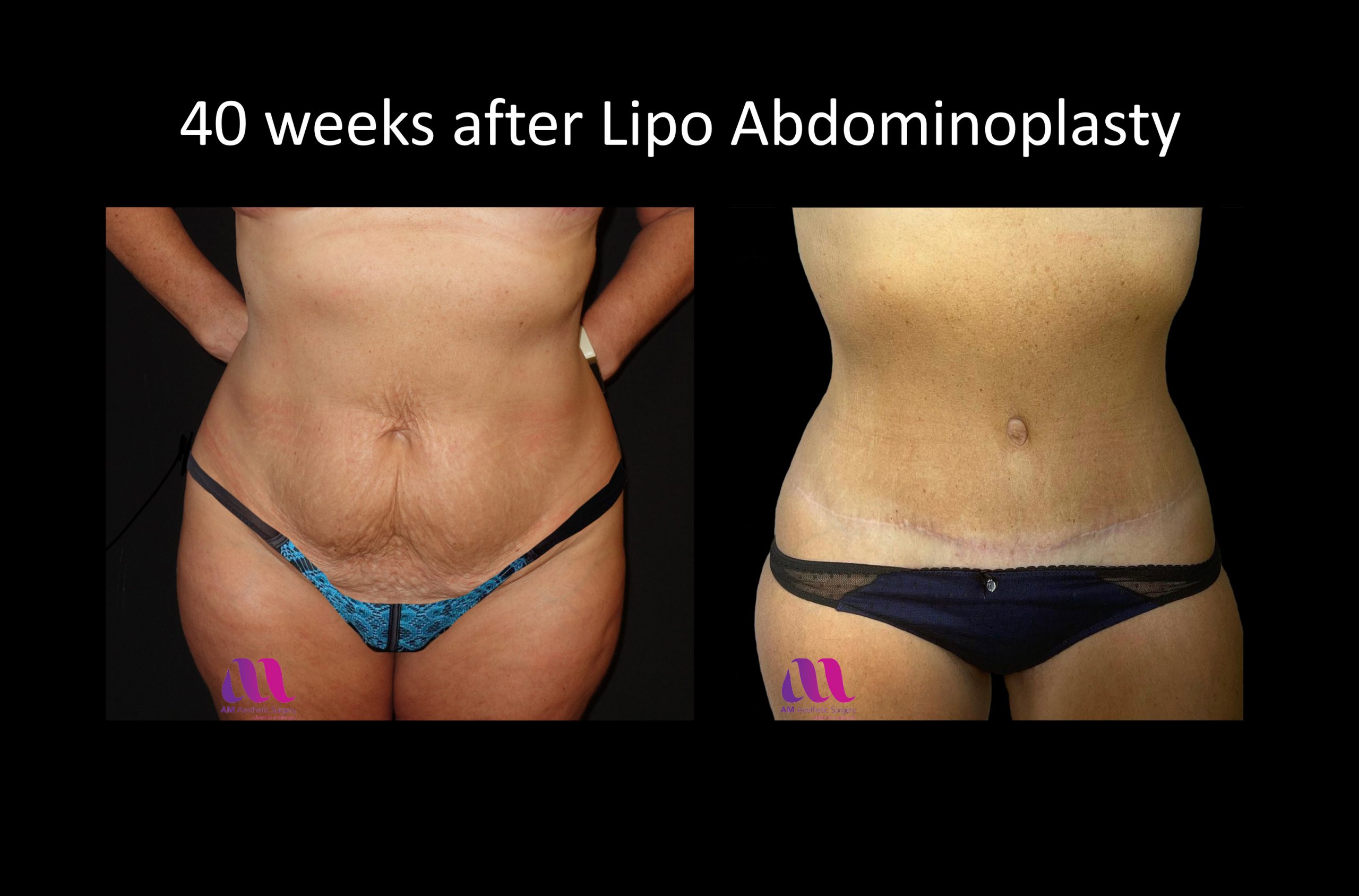Having a tummy tuck procedure to excise excess skin is one thing, but getting rid of the excess and contouring the abdomen at the same time gives you flatter, firmer and well contoured tummy that would allow you to wear smaller figure hugging dresses. Often patients have a problem wearing proper clothes as they have an appropriate chest, but because of the lower body, they end up having to wear larger dresses. Mr Mahajan achieves the ideal figure for you by a combination of various techniques that are customised for your case.
Mr Mahajan plans the procedure to place the scar as inconspicuously as possible. Most patients have excess tissue overhanging the belly button. Mr Mahajan contours the area around the belly button and sculpts it to make it look appealing. Many patients work hard at the gym but are unable to reduce the prominence of their abdomen. A bulging abdomen can be due to various factors. There can be excess fat under the skin that tends to persist in certain areas in spite of exercising. Mr Mahajan addresses this by body sculpting with liposuction. Multiple, large pregnancies can leave you with a split between your tummy muscles, Mr Mahajan addresses this by repairing the split as a part of your tummy tuck procedure if needed. Abdominal bulge can also be caused by excess central abdominal fat inside your tummy wall that has to be reduced with exercise. Although Mr Mahajan cannot directly address this, following a tummy tuck procedure, it is much easier to exercise and loose this yourself.
Patients often come to us for this procedure after contemplating about it for years. After the procedure, they wish that they had had it done ages ago and did not have to live with their sagging large abdomen for all those years.
WHO IS TUMMY TUCK FOR
- Ladies or gents with moderate excess fat and skin of the abdomen
- Ladies or gents who have lost significant amount of weight and have loose excess residual skin
- Ladies who are left with loose overhanging excess skin following pregnancies
- Ladies with a split between the tummy muscles following large pregnancies
WHAT DOES TUMMY TUCK ACHIEVE
- Gets rid of all excess, loose overhanging skin
- Gets rid of excess fat to help contour the tummy wall
- Helps improve aesthetics of the tummy wall and belly button
- Reduces bulging by repairing any split muscles
ABDOMINOPLASTY TECHNIQUES
- Mini Abdominoplasty
- Classical Abdominoplasty
- Lipo Abdominoplasty
- Fleur de lys or Extended Abdominoplasty
ABDOMINOPLASTY NEED-TO-KNOW INFO
Duration of surgery: 2.5 to 4 hours
- Anaesthesia: General Anaesthetic
- Duration of inpatient stay: About 2 nights
- Wounds healed in: 2 weeks
- Scars matured in: Settle in 3 to 6 months, fully matured in 12 to 18 months
- Back to light work (Desk job): 2 weeks
- Back to cardiac exercise / fast walking: 2 to 3 weeks
- Back to labour intensive work / Exercise: 6 to 8 weeks
- Sexual activity: 6 to 8 weeks
- Able to drive: 2 weeks (Should be able to apply emergency stop)
- ‘Long haul’ flights / holidays: Avoid four weeks before and after. Short flights are okay.
- Shower / bath: Keep dressing dry for two weeks, but pamper yourself with a sponge bath.
- Sun bathe: Keep the scars covered or protected with a high factor sun protection cream until they mature in about a year or so.
- Garments: Tummy tuck garment for 8 to 12 weeks as necessary
- Post operative review: 2 weeks, 3 months (As often as necessary if clinically indicated)
- Post Operative pain / discomfort: 2 to 5 days
- Potential risks: (Every effort is made to reduce the risk of complications, but potential risks are) Bleeding, bruising, swelling, haematoma / seroma, infection, delayed wound healing, scars – hypertrophic, stretched, sensitive, higher scars, prominent scars at lateral ends, residual fullness or irregularities, asymmetry, Numbness of abdominal wall / thighs, risks associated with general anaesthetic, blood clots in legs or lungs.
“Mr Mahajan was extremely reassuring and knowledgeable of the procedure and what to expect realistically. The care given from Mr Mahajan and his team was second to none both pre op and post op. I am now three months post op and although was uncomfortable for the first few weeks I am so happy with the results. Finally I can wear figure hugging tops, I feel and look great. One regret is that I didn’t have it done sooner, thank you so much Mr Ajay Mahajan -BK “
“After much thought and research I decided to have a tummytuck and liposuction due to a sagging tummy after having 3 children, as no amount of excerise would shift it. I visited Mr Mahajan, he was very knowledgeable of the procedure. I soon booked in for the procedure and have never looked back since.”
Mr Mahajan will acquire a detailed history from you about your concerns and your medical history. He will take the time to understand your desires and discuss in details as to how he can achieve the results you want. A detailed examination involving assessment of the abdominal tissue, overlying skin and underlying muscles will be noted. Measurements will be taken to gauge the degree of the problem.
Depending on your examination a treatment plan will be formulated tailored to your needs. Depending on the characteristics of your abdomen, Mr Mahajan will discuss surgical options with you. You will together be able to decide the technique of the procedure that will be used to achieve your desired results. There is limit as to how much things can be altered depending on your underlying skeletal structure, this will be assessed and explained to you.
Mr Mahajan feels that a lipo Abdominoplasty delivers the best possible result in most situations, unless the patient has minimal excess fat. Liposuction in combination with tummy tuck helps sculpt out the abdominal area, giving you the shape that you have always desired! The option of having liposuction in conjunction with your tummy tuck can be discussed at the consultation where you will be able to weigh your options and decide. Pattern of the incisions, procedure and subsequent scars will be discussed in detail and you will be given an opportunity to probe into any aspect of the proposed procedure. Once you decide to go ahead following the consultation, you will be required to attend the pre-assessment clinic to ensure you suitability for the procedure under general anaesthetic. You will need to stop smoking (including electronic cigarettes and nicotine patches) and stop any anticoagulant medication such as Aspirin, Warfarin, etc as suggested by Mr Mahajan.
You will be admitted to the hospital on the day of the procedure. The operation will be done under general anaesthesia. It will be carried according to the technique that was planned at the consultation. This will depend on the characteristics of your abdomen and will involve using the approach discussed before.
If liposuction is necessary, this will be done first to reduce the excess subcutaneous fat. Depending on the chosen technique an incision will be made either in the lower abdominal and around the umbilicus only or a vertical incision may be added in cases of extended Abdominoplasty for massive weight loss patients. Dissection is then carefully carried out to undermine the abdominal apron. If there is a split between the muscles, this will be repaired. The area around the belly button is contoured and it is then inset to enhance the aesthetics of this area. The excess tissue is then excised and the wound is closed with absorbable sutures that are placed under the skin.
The procedure can take 2.5 to 4 hours to do depending on the complexity of the case. Mr Mahajan will dedicate as much time as is necessary to create your new aesthetically pleasing form and achieve the results you desire.
Following your procedure, you will be taken to your room, once you have recovered from the anaesthetic. You will be cared for to the highest standards by our well-trained nurses. You will need to rest in bed with the back propped up and your hips and knees flexed so that there is minimal tension on the wound. You may have a catheter for your convenience until you are able to void yourself without any problems. Once you have recovered enough after the surgery, you will be encouraged to sit out of the bed and mobilise to reduce the risks of blood clots in your legs or lungs. You will have some pain and discomfort for 2 to 7 days, but we will ensure that you are comfortable with adequate analgesia.
You can go home as soon as you are comfortable enough to go home. This will be in 2 to 3 days depending on how you feel and removal of your drains. You will have dissolvable sutures and as a result you will not need to endure the discomfort of them being removed and also this will prevent you from getting any stich marks around your scars. Scars are unavoidable following any surgery, but Mr Mahajan aims to make these as neat as possible. Your abdominal wall will be swollen immediately following the surgery. Over the next few months the swelling will gradually go down and the contour of the abdomen will improve. If you have liposuction in combination with your tummy tuck, you will be advised to wear a compression garment for 8 to 12 weeks. Once the swelling has decreased in 3 months or so you can consider investing in new clothes!
You will be seen 2 weeks following the procedure to ensure that your wounds have healed well. After this initial follow up, you will be seen again in 3 months time to assess the results when the swelling has settled reasonably. Mr Mahajan will be available to see you at any time following the procedure should there be any unexpected problem.
The abdomen and chest is considered as one aesthetic unit and it is not uncommon for patients to ask Mr Mahajan to perform a breast uplift / reduction or enhancement to improve the aesthetics of this part of the body. Addressing both the chest and abdomen is the main part of a “mommy makeover” procedure. Options can be discussed with Mr Mahajan at the consultations. As one can imagine, it is not nice to have droopy boobs over shadowing a nicely contoured abdomen!
Is tummy tuck or abdominoplasty for me?
Mr Mahajan does not consider a tummy tuck procedure as a “vanity” procedure. The benefits are significant for a patient has to continuously hide her abdomen. If you have excess overhanging skin with our without moderate excess of fat, then you would benefit from a tummy tuck procedure, with or without liposuction. A tummy tuck procedure is not a solution for excess weight and large amount of fat in abdominal area. Alternatively, if you have lost significant amount of weight, a tummy tuck procedure plays a very important role in tidying up things for you. In patients who have an abdominal bulge as a result of a split between their muscles, repairing the split and restoring the integrity of the abdominal wall helps strengthen the core muscles and may reduce back pain.
What is the most important consideration prior to deciding to have a tummy tuck procedure?
A tummy tuck is a reasonably extensive procedure and recovery can be prolonged. There will be some discomfort in the early days. But a tummy tuck procedure improves the contours of the abdomen significantly and the results can be extremely rewarding. Patients do need to weigh the risk and benefits. Mr Mahajan would be happy to answer any questions to help you decide. Most of Mr Mahajan’s patients comment upon how the procedure has changed their lives.
How do I know if my surgeon is qualified in the field of Plastic Surgery?
MB BS, MB BCh or MB ChB is the basic medical degree of any doctor. Your plastic ‘surgeon’ should at least be a ‘surgeon’. Doctors who receive adequate ‘basic’ surgical training in the UK are awarded Fellowship (FRCSI, FRCS, FRCS Ed, FRCS Gl – in the older generation of surgeons) or Membership (MRCS – in the younger generation of surgeons) of the Royal Colleges in the UK. Doctors or Surgeons, who believe in having a scientific foundation to their practice, spend further years doing research in their fields and are awarded Research degrees such as MSc, MMedSc, MPhil, MD or PhD. Surgeons who ‘train specifically in the field of Plastic surgery’ are awarded FRCS (Plast). These surgeons are then entitled to be on the “Specialist register for Plastic Surgery” with the General Medical Council (GMC).
How do I choose amongst the Plastic Surgeons who fit the above criteria?
‘Safe’ and ‘beautiful’ results are dependent on ‘experience’ and ‘expertise’ of your plastic surgeon. Mr Mahajan is a highly trained and experienced plastic surgeon who is a Consultant Plastic Surgeon at the Bradford Teaching Hospitals NHS Foundation Trust / Calderdale and Huddersfield NHS Foundation Trust and is the Director of the prestigious Plastic Surgery and Burns Research Unit (PSBRU) at the University of Bradford. He has worked in world-renowned centres for aesthetic surgery in Belgium, Sweden and Switzerland in addition to his training in the UK. He is a full member of the British Association of Plastic Surgeons (BAPRAS), British Association of Aesthetic Plastic Surgeons (BAAPS), European Association of Plastic Surgeons (EURAPS), UK Association of Aesthetic Plastic Surgeons (UKAAPS), American Society of Plastic Surgeons (ASPS), Association of Breast Surgeons (ABS) and is on the Specialist register for plastic surgery with the General Medical Council (GMC). Surgeons are only awarded membership of these associations if they are properly qualified and it is a reassurance for you that you are in safe hands. In addition to this, it obviously helps if your surgeon has travelled the world to enhance his training in premier institutes to learn from leading surgeons in their fields. It also helps if your surgeon believes in practicing “evidence based medicine” by engaging in research activities to help establish a scientific background to his / her clinical practice.
Where will my surgery take place?
Your surgery will take place in ‘local’ reputed hospitals such as the Yorkshire Clinic or the Spire Elland Hospital, where you will be able to return to ‘anytime’ after the operation should there be any concerns.
How much will the procedure cost?
Cost of tummy can be about £5010 to £7050 depending on whether it is classic tummy tuck, extended tummy tuck or combined with liposuction customised according to your needs. Mr Mahajan will discuss this with you when you meet him. You may find cheaper deals with firms that consider cosmetic procedures as a business, but may end up compromising on safety, quality and convenience. Although tummy tuck may be considered as a cosmetic procedure, it is a plastic surgical ‘operation’ and you do need to appreciate this and consider it with all the seriousness that it deserves. Medical tourism has certainly made costs cheaper, but the very fact that you are boarding a long haul flight puts you at risk of blood clots in your legs or lungs that can be life threatening. There are obviously other matters to consider such as qualifications, experience and expertise of your surgeon / anaesthetist apart from the ability to see your surgeon again should there be a problem after you have flown back home.
Which procedure would suit me best?
Mr Mahajan will carry out a detailed examination to determine the exact nature of your tummy and the areas that need to be addressed. This will be explained to you and an appropriate procedure will be selected in discussion with you.
If you have minimal excess loose abdominal skin mainly below the belly button, then a mini abdominoplasty would suffice.
If you have significant excess overhanging skin, that is spread above and below your belly button, then you would need a full abdominoplasty. Quite a few patients see Mr Mahajan wishing to have a mini tummy tuck, but in reality there is usually enough excess skin to perform a full abdominoplasty that gives you a much better outcome. Patients understandably wish to have the smallest procedure possible, but the rewards of having a bigger procedure (if indicated) are significantly more. A classic abdominoplasty helps remove the excess skin and tidy up the abdominal wall.
A lipo abdominoplasty not only removes the excess skin, but also helps sculpt the abdomen in to a beautiful shape, especially by liposuction of the ‘love handles’ areas (unless you wish to retain them for practical reasons!!). Lipo abdominoplasty is certainly indicated in patients who have generalised moderate excess of fat and skin. It is however not an option for reducing weight in patients with a high BMI.
Patients who have lost significant amount of weight and are left with a lot of loose hanging skin that is in excess in both horizontal and vertical directions, benefit from an extended tummy tuck or Fleur de lys procedure, which helps tidy up the abdominal wall.
After choosing the appropriate technique to achieve the goal, the end outcome is known to give the patient a very high level of satisfaction. A tummy tuck procedure is one of the most satisfying plastic surgical operation.
Do my stretch marks disappear after a tummy tuck procedure?
All stretch marks present below the belly button with be gone with the excess skin that is removed. Any stretch marks present above the belly button will remain. They will however be shifted downwards. There is a possibility that the stretch marks above the belly button may become longer as this skin will be stretched down across the abdomen to reach low down to your abdominoplasty scar. The stretch marks will however be stretched in their long axis and may become less conspicuous… this is hard to predict.
Will I have long standing results following a tummy tuck?
The excess skin that is removed is permanently gone and this is permanent. The excess fat that is removed by liposuction is also permanently gone, however if the patient gains weight in future, the fat cells that are left behind tend to grow in size. It is down to the patient to maintain their weight following a lipo abdominoplasty procedure.
Can I become pregnant again if I have a tummy tuck?
There is no issue with becoming pregnant again following a tummy tuck procedure. However, depending on the elasticity of the skin and its ability to retract, the benefits of having had a tummy tuck may be compromised and you may be left with some loose skin again. You should work on your tummy to regain the muscle tone after the pregnancy to minimise loss of contour of your abdomen. If you are planning on having children in the near future, it is best to wait until after your pregnancy. You should wait for atleast six months following a pregnancy before contemplating on a tummy tuck procedure.
Do I need to stop my medication?
If you are on the oral contraceptive pill, you will need to stop these 4 weeks before the procedure to reduce your risks of blood clots in legs or lungs. Also, you will need to stop any blood thinning drugs. Aspirin and Clopidogrel will need to be stopped a week prior to surgery. Warfarin, Dabigatran etexilate, Rivaroxaban and Apixaban need to be stopped 4 days prior to surgery. Mr Mahajan will discuss this with you in the pre operative consultation.
Will I need to have a general anaesthetic?
Yes, you will need a general anaesthetic to undergo the procedure. It will take about 2.5 to 4 hours to do the operation for you. Your anaesthetist will be fully qualified and a member of the Royal college of Anaesthetists. He will ensure that you have a smooth anaesthetic procedure and are comfortable during your recovery.
Are there any risks?
Every effort is made to reduce the risk of complications, but potential risks are Bleeding, bruising, swelling, haematoma / seroma, infection, delayed wound healing, scars – hypertrophic, stretched, sensitive, higher scars, prominent scars at lateral ends, residual fullness or irregularities, asymmetry, Numbness of abdominal wall / thighs, risks associated with general anaesthetic, blood clots in legs or lungs.
How long will I have to stay in the hospital?
You will have surgical drains after the procedure and you may need to stay in hospital for a couple of nights, until you are comfortable enough to go home and your drains are removed.
When will I be seen again after I am discharged from the hospital?
You will usually be seen by Mr Mahajan 2 weeks following your procedure to ensure that the wounds have healed well. Following this initial review, you will be seen again in 3 months. However, if there are any concerns, you will be seen by Mr Mahajan as often as is necessary.
Is there any thing that I need to look out for?
Although you will only be discharged from the hospital when Mr Mahajan is satisfied that you doing well following your surgery, you do need to look out for sudden increase in swelling of the abdomen, disproportionate pain, any signs of infection such as feeling unwell, temperature, redness around the scars, discharge or foul odour from the wounds. Your tummy wall may be a bit bruised after the procedure, but should any part of the skin colour change to purple, it could be sign of compromised circulation and you should return to see Mr Mahajan. One should also look out for any painful swelling of the calf or shortness of breath that might suggest a blood clot. If this happens, please contact us immediately.
What if I have a problem after I am discharged from the hospital?
You will be discharged from the hospital when it is safe enough to do so. However, in the event of any unexpected problems, you can contact us any time on 0800 246 5636.
Will I need to wear any special garments?
You will need to wear a abdominal support garment if you have had a lipo abdominoplasty procedure. A garment is not necessary if you have had a classic abdominoplasty. Mr Mahajan will discuss this with you during your preoperative consultation. It would be ideal to wear this for about eight to twelve weeks following the procedure.
Will I be in pain?
Patients do tend to have some pain and discomfort for the first 2 to 5 days, but you will be kept comfortable with adequate analgesia. It is advisable to take Paracetamol six hourly on a regular basis for the first 24 to 48 hours and then as necessary after that.
Will my abdomen be swollen?
Your abdomen will indeed be swollen immediately after the procedure. The swelling takes time to settle and it will be significantly less a month following the procedure. It takes about three months for it to settle reasonably. It continues to further settle gradually after that and can take up to a year for the end result to be apparent. You may however, collect fluid (seroma) in your abdominal wall following the surgery in the first week or two. This is not unexpected and tends to be more common following a lipo abdominoplasty procedure. Should this happen, the fluid will need to be drained with a syringe through your skin. You may need this repeated at weekly intervals until it settles. Mr Mahajan will follow you up closely as often as necessary.
Will the sensation in my abdomen be affected?
The sensation to the lower abdominal wall tends to be reduced immediately after, as the abdominal wall is undermined during surgery. Sensation tends to recover in about three months or so. There may however be some permanent decrease in sensation.
Do I need to massage my tummy?
Massaging the abdominal wall towards the sides can help reduce swelling of the abdominal wall after the wounds have healed. You will also need to massage the scars once your wounds have healed in two weeks time.
When will I be seen again after I am discharged from the hospital?
You will usually be seen by Mr Mahajan 2 weeks following your procedure to ensure that the wounds have healed well. Following this initial review, you will be seen again in 3 months. However, if there are any concerns, you will be seen by Mr Mahajan as often as is necessary.
What position can I sleep or sit in?
Immediately after the procedure, you will be most comfortable lying on your back with the back propped up at 45 degrees or so and pillows under your knees to keep your hips and knees flexed so that there is no tension on the wound as it is healing. You may lie on your side if you are more comfortable in this position, but you do need to keep your hips and knees flexed. You can assume any sleeping position once the wounds have healed in two weeks time. It is however better to avoid sleeping on your tummy until your posture is fully straight with no tension on the wound. Sitting in a chair is not a problem as your hips and knees tend to flexed in a sitting posture and thereby there is no tension on your wound.
How long will it take for my wounds to heal?
It takes about two weeks for the wounds to heal up. At times, wound healing can be delayed at the middle of the wound where the blood supply is the least and tension is the most. You will need dressings until the wounds are healed in two weeks, but if wound healing is delayed is some areas, you will need dressings here until the wounds are fully healed.
When do my stitches come out?
Mr Mahajan uses absorbable sutures to close the wounds. This helps him achieve neat scars and prevent ‘hatch marks’ from external sutures. This also means that you will not have the discomfort of having your sutures removed.
When can I shower or have a bath?
You should wait ideally wait for two weeks until your wounds are healed and dressing are removed before you have a bath. However you can wash yourself and have a sponge bath keeping the dressing dry as soon as you are able to.
Where will my scars be?
In a classic tummy tuck procedure, you will have a scar in the lower abdominal area. The scar will be placed as low down as possible and as inconspicuously as possible. Many plastic surgeons talk about hiding the scar in the panty line… this is not always possible especially considering the amount of material that goes into making a fashionable panty in these days of global warming (pic of global warming)! There will also be a scar around the belly button to resurface it as the upper abdominal skin is pulled down over it.
In an extended tummy tuck procedure, there will be an additional vertical scar in the middle of the abdomen to help excise the vertical excess abdominal skin. Although this scar is conspicuous, the benefits of loosing the large excess of skin in this area tends to far outweigh the disadvantages of having a scar in this area.
How long will it take for my scars to settle?
Scars are pink to start with, but over time they tend to become less prominent and fade. Scars tend to settle reasonably in 3 to 6 months. However, it takes about 12 to 18 months for scars to settle fully. Scars can at times be thickened (hypertrophic) especially in younger patients. This might require treatment with silicone creams or steroid injections.
What can I apply to my scars to help them settle better?
It is important to massage the scars once they are healed. This helps them settle better. Some patients claim that Bio oil helps scars settle better, but any moisturising cream should be good enough. If there is any indication of the scars becoming thicker, then silicone based creams should be considered.
What will my belly button look like?
In most patients, the belly button is buried in a deep recess and often has an overhang of tissue over it. At the tummy tuck procedure, Mr Mahajan focuses on improving the aesthetics of the belly button to contour the area around it and create an aesthetic looking belly button. In a lipo abdominoplasty, Mr Mahajan aims to create a so called ‘champagne gutter’ leading to the umbilicus…!
When can I sun bathe?
It is always advisable to protect your skin in the sun. In particular, your new scars are susceptible to sun damage until they mature in about a years’ time or so. You should keep the scars covered or protected with a high factor sun protection cream until then.
When can I go back to work?
This depends on your job. If you have a desk job that does not involve lifting any things heavy, you can go back to work as soon as you are comfortable and this could be in about two weeks or less. However, if you have a more demanding job, you will need to take a break for four to 6 to 8 weeks. This can vary widely between patients, as patients tend to cope variably.
When can I pick up my baby?
You will need to wait for about 2 to 3 weeks until your wound have healed and your posture is back to normal. Alternatively, your partner could give the baby to you to hold gently. Do not try to restrain an aggressive child as you would harm yourself.
When can I hit the gymn again?
You will need to wait until your wounds have fully healed and you are comfortable to under take any labour intensive work. This could take 6 to 8 weeks following your surgery. You could however return to light cardiac exercises sooner in about 2 to 3 weeks.
When can I drive?
You will need to wait until you are comfortable to do so. This might mean waiting till your wounds have healed in two weeks time. You should be able to apply an emergency stop and it is a decision that you will have to make.
When can I fly or go on holidays?
Holidays after surgery will do you good and give you time to recuperate. However, it is not advisable to go on long haul flights for 4 weeks after the procedure to reduce the risks of blood clots in your legs or lungs. Blood clots in your lungs can be life threatening and is a very compelling reason for you not to consider traveling across the globe in search of cheap deals. Short flights and travel by train or car, which does not involve prolonged periods of immobilisation, is not a problem although you should take precautions to wear flight socks when travelling.
Although I am not in any rush, when can I have sex again?!
You will need to wait until your wounds have fully healed and you are comfortable to engage in any sexual activity. This could take 6 to 8 weeks following your surgery.
When can I drink or smoke?
There is no issue with having a social drink after the procedure. However, patients do need to refrain from smoking completely for at least three weeks following the procedure. You would have had to stop smoking for eight weeks before the operation. Smoking tends to reduce the circulation of blood, which is vital for wound healing. This applies to nicotine patches or electronic cigarettes too. Considering that you would have stopped smoking for about 3 months around the date of your procedure, you should take this as an opportunity to stop smoking completely!
Book chapters:
Influence of rNAPc2 in the evolution of a burn wound: a promising therapeutic option for the management of burns.
Ajay L Mahajan
Presented to the National University of Ireland, Galway, 2006. Thesis of research work towards degree of Doctor of Medicine (MD)
Principles of free flap design and elevation
Phillip N Blondeel and Ajay L Mahajan
Operative Microsurgery, edited by Brian Boyd, MD and Neil Jones, MD. McGraw-Hill, New York, 2015.
Photography in Plastic Surgery
Ajay L Mahajan
Text Book of Plastic, Reconstructive & Aesthetic Surgery, edited by Karoon Agarwal, in Print
Original Articles
- Progressive tissue injury in burns is reduced by rNAPc2
AL Mahajan, X Tenorio, KU Schlaudraff, MS Pepper, D Baetens, D Montandon, B Pittet
Burns. 2006 Dec;32(8):957-63. Epub 2006 Aug 14.
- Early detection of flap failure using a new thermographic device
X Tenorio, AL Mahajan,, R Wettstein, Y Harder, M Pawlowsky, B Pittet
J Surg Res. 2009 Jan;151(1):15-21. Epub 2008 Apr 4.
- Optimising the arterialised venous flap
Pittet B, Quinodoz P, Alizadeh N, Schlaudraff K-U, Mahajan AL
Plast Reconstr Surg. 2008 Dec;122(6):1681-9.
- What should count as a “perforator flap”? R Sinna, A. Boloorchi, A L Mahajan, Q. Qassemyar, M. Robbe
Plast Reconstr Surg. 2010 Dec;126(6):2258-63.
- Localizing Perforators vessels by Dynamic Infrared Imaging and Flow Doppler without thermal cold challenge
X Tenorio, AL Mahajan, B Elias , J Schaepkens Van Riempst, R Wettstein, Y Harder, B Pittet
Ann Plast Surg. 2011 Aug;67(2):143-6.
- Bipedicled DIEP flaps for reconstruction of soft-tissue deficiencies in male patients.
A L Mahajan, P Cadenelli, F Thiessen, P Blondeel, F Stillaert
JPRAS, in print
Ideas and Innovations
7. Why have Paper when you can have Silk?!
A L Mahajan, C L Riordan, P J Regan
Plast Reconstr Surg. 2003; 111(5):1759-1760
- Flexor Tendon Reconstruction using FDP “Demi-Tendon”
A L Mahajan, C L Riordan, M Hussain, W Brennan, B Murphy, P McHugh, P J Regan
Ir J Med Sci. Vol. 171, No.3 July/Aug/Sept 2002
- The ‘fingers fan out’ sign: stick out your palmaris longus even better!
AL Mahajan
Br J Plast Surg; 2005; 58(2): 278-279
Case Reports, Correspondence and Published Abstracts
- Digital Imaging and its role in our day to day work
A L Mahajan, J Lynch, A J Hussey, J McCann, P Regan
Ir J Med Sci. Vol. 169, No.3 July/Aug/Sept 2000
- Vacuum Assisted Closure (VAC) therapy and its’ use in a Plastic Surgery Department
J Lynch, A J Hussey, A L Mahajan, JJ McCann, PJ Regan
Ir J Med Sci. Vol. 169, No.3 July/Aug/Sept 2000
- A Comparison of Hydrophilic Polyurethane and Alginate Dressings in the Treatment of SSG Donor Sites
A J Hussey, A L Mahajan, JB Lynch, JJ McCann, PJ Regan
Ir J Med Sci. Vol. 170, No.3, July/Aug/Sept 2001
- Tolls of a trek up Croagh Patrick – Friction / Frost Burns of the foot
A L Mahajan, P J Regan
Burns 2004 May; 30(3):283-285.
- Could your case of Necrotising fascitis be Pyoderma Gangrenosum?!
AL Mahajan, N Ajmal, J Barry, L Barnes, D Lawlor
Br J Plast Surg. 2005 Apr; 58(3):409-12.
- Dynamic Infrared Imaging in Reconstructive Surgery
Xavier Tenorio, Ajay Mahajan, Denys Montandon, Brigitte Pittet
Plast Reconstr Surg. 2005 Sept Vol. 116,No.3 supplement
- New therapeutic intervention with rNAPc2 curbs progression of the burn wound
AL Mahajan, X Tenorio, KU Schlaudraff, MS Pepper, D Baetens, D Montandon, B Pittet
Ir J Med Sci. 2004 173(3) S1
- Iatrogenic full-thickness chemical burns from monochloracetic acid.
Chapman T, Mahadevan D, Mahajan A, Perez-Temprano A, McDiarmid J.
J Burn Care Res. 2006 Jul-Aug;27(4):545-7.
- Dynamic Infrared Imaging : a new tool in flap perfusion monitoring
Xavier Tenorio, Ajay Mahajan, Marek Pawlowski, Brigitte Pittet
J Plast Reconstr Aesthet Surg. 2006;59(9): S5
- A novel use of vascularised free fibula graft as a bracket to stabilize severe cervico-
thoracic kyphosis associated with neurofibromatosis type 1
TWL Chapman, N. M. Harris, V Rachapalli, AL Mahajan, AR Fitton
Eur J Plast Surg 2007 Feb;29(6):299-301
- Lichtenberg figures – Cutaneous manifestations of Phone Electrocution
AL Mahajan, R Rajan, P J Regan
J Plast Reconstr Aesthet Surg. 2008;61(1):111-3. Epub 2007 Jul 30.
- A loose body can simulate a dorsal wrist ganglion
V Rachapalli, AL Mahajan, WG Thomas.
The Internet Journal of Plastic Surgery. 2007; 4(1).
- Patient contribution during microvascular surgery!
AL Mahajan, E Newton Dunn, A R Fitton
J Plast Reconstr Aesthet Surg. 2008 Nov;61(11):1337. Epub 2008 Aug 8
- Optimal environment for free flaps can also be a haven for fungi!
VA Mahajan, AL Mahajan, B H Harte, KJ Cronin
J Plast Reconstr Aesthet Surg. 2009 Dec;62(12):e661-2. Epub 2009 Feb 8.
- Optimising success in revascularising fingers by using the ‘H’ vein graft
J K Dickson , V A Mahajan, J M Taylor, R Rajan, A L Mahajan
Ir J Med Sci. 2009 Sept;178 (7):S243
- Periungual Pilonidal sinus
P Ngan, A Varey, A L Mahajan
J Hand Surg Eur Vol. 2011 Feb;36(2):155-7.
- Rationalising treatment of Raynaud’s syndrome
D Nikkhah, J Rodrigues, A L Mahajan
J Plast Reconstr Aesthet Surg 2012 Jul;65(7):986
PRESENTATIONS
- Skin Cancer Triage Clinic – Twelve Month review in UCHG
J Lynch, A L Mahajan, A J Hussey, J McCann, P Marren, P Regan
Sylvester O’Halloran Meeting, Limerick, March 2000
(Poster Presentation)
- Skin Cancer Triage Clinic – Twelve Month review in UCHG
J Lynch, A L Mahajan, A J Hussey, J McCann, P Marren, P Regan
British Association of Plastic Surgeons Meeting, Birmingham, July 2000
- Digital Imaging and its role in our day to day work
A L Mahajan, J Lynch, A J Hussey, J McCann, P Regan
Sir Peter Freyer Millennium Meeting, Galway, September 2000
- Vacuum Assisted Closure (VAC) therapy and its’ use in a Plastic Surgery Department
J Lynch, A J Hussey, A L Mahajan, JJ McCann, PJ Regan
Sir Peter Freyer Millennium Meeting, Galway, September 2000
- A Comparison of Hydrophilic Polyurethane and Alginate Dressings in the treatment of SSG Donor Sites
A J Hussey, A L Mahajan, JB Lynch, JJ McCann, PJ Regan
Scottish-Irish Plastic Surgeons Meeting, Belfast, October 2000
(Poster Presentation)
- Vacuum Assisted Closure (VAC) therapy and its’ use in a Plastic Surgery Department
J Lynch, A J Hussey, A L Mahajan, JJ McCann, PJ Regan
Scottish-Irish Plastic Surgeons Meeting, Belfast, October 2000
- First Aid in Burns
A L Mahajan (Instructional Presentation)
4th Annual Burns Symposium, Galway, January 2001
- Why have Paper when you can have Silk?!
A L Mahajan, P Regan
Irish Association of Plastic Surgeons Meeting, Galway, May 2001
- Digital Imaging and its role in our day to day work
A L Mahajan, J Lynch, A J Hussey, J McCann, P Regan
Irish Association of Plastic Surgeons Meeting, Galway, May 2001
- Digital Imaging – A diagnostic aid in Skin Cancer
A L Mahajan, J Lynch, A J Hussey, J McCann, P Marren, P Regan
British Association of Plastic Surgeons Meeting, Sterling, July 2001
(Paper Presentation)
- Digital Imaging – A diagnostic aid in Skin Cancer
A L Mahajan, J Lynch, A J Hussey, J McCann, P Marren, P Regan
British Association of Plastic Surgeons Meeting, Sterling, July 2001
(Poster Presentation)
- A Comparison of Hydrophilic Polyurethane and Alginate Dressings in the Treatment of SSG Donor Sites
A J Hussey, A L Mahajan, JB Lynch, JJ McCann, PJ Regan
Sir Peter Freyer Meeting, Galway, September 2001
- Management of Burns and Fluid Resuscitation
A L Mahajan (Instructional Presentation)
5th Annual Burns Symposium, Galway, April 2002
- Self Inflicted Wrist Lacerations – a 5 year morbidity & mortality study
A L Mahajan, L Rynn, S Kilgannon*, J McCann, P Regan
Irish Society for Surgery of the Hand Meeting, April 2002
- Reconstruction of FDP tendon using it’s demi tendon
CL Riordan, AL Mahajan, M Hussain, W Brennan, B Murphy, P McHugh, P J Regan
Irish Society for Surgery of the Hand Meeting, April 2002
“Best Paper Prize”
- Reconstruction of forearm hernias
M Hussain, CL Riordan, AL Mahajan, P J Regan
Irish Society for Surgery of the Hand Meeting, April 2002
- Web Ferret – The efficient way to search the net
A L Mahajan, L Rynn, J McCann, P J Regan
Irish Association of Plastic Surgeons Meeting, Cork, May 2002
- Abdominoplasty
P J Regan, A L Mahajan (Instructional Presentation)
Irish Association of Plastic Surgeons Meeting, Cork, May 2002
- Flexor Tendon Reconstruction using FDP “Demi-Tendon”
A L Mahajan, C L Riordan, M Hussain, W Brennan, B Murphy, P McHugh, P J Regan
Sir Peter Freyer Meeting, Galway, September 2002
- Digital Imaging – A diagnostic aid in Skin Cancer
A L Mahajan, J Lynch, A J Hussey, J McCann, P Marren, P Regan
Sir Peter Freyer Meeting, Galway, September 2002
(Poster Presentation)
- Initial Review of Lasers in Treatment of Skin Lesions
A L Mahajan, K Murphy, A Grufferty, J McCann, P J Regan
Sir Peter Freyer Meeting, Galway, September 2002
(Poster Presentation)
- Burns – The Paediatric Patient
A L Mahajan (Instructional Presentation)
6th Annual Burns Symposium, Galway, February 2003
- Soft tissue infection & Necrotising fascitis in IVDA patients
A L Mahajan, J Kerr, D Lawlor, P Eadie
Irish Association of Plastic Surgeons Meeting, Galway, April 2003
- Experimental model to understand the mechanism of survival of arterialized-venous (AV) flap.
B Pittet, P Quinodoz, N Alizadeh, K-U Schlaudraff, A L Mahajan
7th European Conference of Scientists and Plastic surgeons, Geneva, September 2003
“Best Paper Prize”
- Experimental model to understand the mechanism of survival of arterialized-venous (AV) flap.
B Pittet, P Quinodoz, N Alizadeh, K-U Schlaudraff, A L Mahajan
European Association of Plastic Surgeons meeting, Genoa, Italy, May 2004
- New therapeutic intervention with rNAPc2 curbs progression of the burn wound
AL Mahajan, X Tenorio, KU Schlaudraff, MS Pepper, D Baetens, D Montandon, B Pittet
Sir Peter Freyer Meeting, Galway, September 2004.
27.Application of rNAPc2 reduces Secondary Aggravation of Burn Wounds.
X Tenorio, AL Mahajan, KU Schlaudraff, MS Pepper, D Baetens, D Montandon, B Pittet
European Congress of Scientists and Plastic Surgeons, Munich, October 2004
- Diminution de l’aggravation secondaire des brûlures chez le rat par l’application
intraveineuse de l’anticoagulant rNAPc2
Schlaudraff, K-U; Mahajan AL; Pepper MS; Tenorio X; Montandon D; Pittet, B
French Society of Plastic Reconstructive Aesthetic Surgery, Paris, November 2004
- Secondary aggravation of burns is reduced by rNAPc2.
Tenorio X, SchlaudraffK.-U, Mahajan AL, Pepper M.S, Montandon D, Pittet B.
8th Joint Scientific Meeting,Universities of Geneva and Lausanne,
Changins-Switzerland, October 2004. (Poster).
- Progressive tissue injury in burns is reduced by rNAPc2
AL Mahajan, KU Schlaudraff, X Tenorio, MS Pepper, D Baetens, D Montandon, B Pittet
British Burns Association meeting, York, UK, April 2005
“Best Paper Prize”
- Dynamic Infrared Imaging in Reconstructive Surgery
Xavier Tenorio, Ajay Mahajan, Denys Montandon, Brigitte Pittet
Plastic Surgery 2005 (ASPS meeting), Chicago, USA, September 2005
(Poster Presentation)
- Dynamic Infrared Imaging : a new tool in flap perfusion monitoring
Xavier Tenorio, Ajay Mahajan, Marek Pawlowski, Brigitte Pittet
European Congress of Scientists and Plastic Surgeons, Leuven, Belgium,September 2005
(Published abstract J Plast Reconstr Aesthet Surg. 2006;59(9): S5)
- Secondary aggravation of burn wounds and its detrimental influence on post burn sequelae – an underestimated clinical phenomenon?
Schlaudraff, K-U; Mahajan AL; Pepper MS; Tenorio X; Montandon D; Pittet, B
Swiss Congress of Plastic Surgeons, Beine, Switzerland, September, 2005.
- Dynamic Infrared Imaging and applications in plastic surgery.
Xavier Tenorio, Ajay Mahajan, Marek Pawlowski, Brigitte Pittet
Swiss Congress of Plastic Surgeons, Beine, Switzerland, September, 2005.
- Dynamic Infrared Imaging: a new tool in flap perfusion monitoring.
Xavier Tenorio, Ajay Mahajan, Marek Pawlowski, Brigitte Pittet
Joint Scientific Meeting,Universities of Geneva and Lausanne,
Changins-Switzerland, October 2005.
- Tumour to tumour metastasis of Malignant Melanoma
AL Mahajan, M Naveed, TWL Chapman, A Perez-Temparano CBA Lyons*, RJ Morris
British Asscn. of Plastic Aesthetic & Reconstructive Surgeons Meeting, Sheffield, July 2006
(Poster Presentation)
- Location of vascular perforators by dynamic infrared imaging: Helpful tool or preoperative gadget?
X Tenorio, AL Mahajan, Y Harder, B Elias, D Montandon, J Schaepkens, M Pawlovski,
B Pittet
European Congress of Scientists and Plastic Surgeons, London, September 2006
- Audit of Free and Major pedicled flaps
S Salam, TWL Chapman, AL Mahajan
South West supra regional audit, Salisbury, November 2006
- Lichtenberg figures – Cutaneous manifestations of Phone Electrocution from lightning
A L Mahajan, R Rajan, P J Regan
British Asscn. of Plastic Aesthetic & Reconstructive Surgeons Meeting, London, Dec 2006
(Poster Presentation)
- Lichtenberg figures – Cutaneous manifestations of Phone Electrocution from lightining
A L Mahajan, R Rajan, P J Regan
Irish Association. of Plastic Surgeons Meeting, Galway, May 2007
(Poster Presentation)
- Optimising the arterialised venous flap
Mahajan AL, Quinodoz P, Alizadeh N, Schlaudraff KU, Pittet B
Irish Association. of Plastic Surgeons Meeting, Galway, May 2007
(Poster presentation)
- Optimal environment for free flaps can also be a haven for fungi!
AL Mahajan, R Rajan, TWL Chapman, KJ Cronin
Irish Association. of Plastic Surgeons Meeting, Galway, May 2007
(Poster presentation)
- Optimising the arterialised venous flap
AL Mahajan, Quinodoz P, Alizadeh N, Schlaudraff K-U, Pittet B
International Plastic Reconstructive & Aesthetic Surgeons meeting, Berlin, June 2007
(Poster Presentation)
- Lichtenberg figures – Cutaneous manifestations of Phone Electrocution from lightning
A L Mahajan, R Rajan, P J Regan
International Plastic Reconstructive & Aesthetic Surgeons meeting, Berlin, June 2007
(Poster Presentation)
- Optimal environment for free flaps can also be a haven for fungi!
AL Mahajan, R Rajan, TWL Chapman, KJ Cronin
International Plastic Reconstructive & Aesthetic Surgeons meeting, Berlin, June 2007
(Poster Presentation)
- Pressure sore – Donor site morbidity of the sural nerve
AL Mahajan, TWL Chapman, R Rajan
International Plastic Reconstructive & Aesthetic Surgeons meeting, Berlin, June 2007
(Poster Presentation)
- ‘See and Treat’ Plastic Surgical Clinic Audit
R Rajan, AL Mahajan, NPM Jain, S Wharton
Skin Cancer Audit Day, Exeter, Sept 2007
- Case presentation
AL Mahajan, VS Devaraj
7th Regional Sarcoma study day, Cullompton, October 2007
- Clinical Photography and the Plastic Surgeon
AL Mahajan
3rd International tutorials in Aesthetic Surgery, Mumbai, India, Jan 2008
- The ‘H’ Vein Graft for Revascularisation of Fingers
V A Mahajan, J M Taylor, A L Mahajan
British Asscn. of Plastic Aesthetic & Reconstructive Surgeons Meeting, Leeds, July 09
(Poster presentation)
- Optimising success in revascularising fingers by using the ‘H’ vein graft
V A Mahajan, J M Taylor, R Rajan, A L Mahajan
Irish Association. of Plastic Surgeons Meeting, Galway, May 2009
(Poster presentation)
- Optimising success in revascularising fingers by using the ‘H’ vein graft
J K Dickson , V A Mahajan, J M Taylor, R Rajan, A L Mahajan
XXXIVth Sir Peter Freyer Surgical Symposium meeting, Galway, Ireland, Sept 2009.
- Optimising success in revascularising fingers by using the ‘H’ vein graft
V A Mahajan, J M Taylor, R Rajan, A L Mahajan
International Plastic Reconstructive & Aesthetic Surgeons meeting, Delhi, Nov 2009
- Influencing the outcome of the burn wound
A L Mahajan, X Tenorio, B Pittet
International Plastic Reconstructive & Aesthetic Surgeons meeting, Delhi, Nov 2009
(Poster presentation)
- ‘Punch biopsy’ injury to median nerve
J M Taylor, R Rajan, A L Mahajan
International Plastic Reconstructive & Aesthetic Surgeons meeting, Delhi, Nov 2009
(Poster presentation)
- Bipedicled DIEP flaps for reconstruction of soft-tissue deficiencies in male patients.
A L Mahajan, P Cadenelli, F Thiessen, P Blondeel, F Stillaert
British Asscn. of Plastic Aesthetic & Reconstructive Surgeons Meeting,, Sheffield, July 2010
- Bipedicled DIEP flaps for reconstruction of soft-tissue deficiencies in male patients.
A L Mahajan, P F Cadeneli, C Van Waes, P Blondeel, K Van Landuyt, F Stillaert
World Congress on Controversies in Plastic Surgery & Dermatology (CoPLASDy)
Barcelona, November 2010 (Poster presentation)
- Bipedicled DIEP flaps for reconstruction of soft-tissue deficiencies in male patients.
A L Mahajan, P F Cadeneli, C Van Waes, P Blondeel, K Van Landuyt, F Stillaert
IInd Italian Meeting on Perforator Flaps and Aesthetic Refinements
Bologna, Italy. November 2010
- Microvascular architecture of a DIEP flap harvested from an abdomen with a
Pfannenstiel scar.
A L Mahajan, A Zeltzer, K E Y Claes, K Van Landuyt, M Hamdi
European Association of Plastic Surgeons meeting, Mykonos, Greece, June 2011.
- Abdominal seroma formation following DIEP flap harvest –
analysis of influencing factors and development of a predictive formula
K Seidenstücker, B Munder, A L Mahajan, C Andree
European Association of Plastic Surgeons meeting,, Munich, Germany May, 2012
- Classical IMV dissection
A L Mahajan
French Perforator Flap (ACRWP) course, Amiens, France, June 2012
- Aesthetic Surgery – Dawn to a new you
A L Mahajan
ATMG Meeting, Alton Towers, UK September 2013
- Bipedicled DIEP flaps for extensive lower limb injuries
A L Mahajan,
APSICON, Mumbai, India, November 2013
- Operative therapy in Supramicrosurgery technique
K Seidenstücker, B Munder, A L Mahajan, C Andree
International Breast Symposium, Dusseldorf, April 2014
- Trauma Service Reorganisation, The Bradford Experience
O Tillo, D Watt, A L Mahajan
ESPRAS Meeting, Edinburgh, July 2014
- The David Sharpe Fellowship
A L Mahajan
BAPRAS, London, Nov 2014
- Aesthetic surgery – Psychological and functional benefits
A L Mahajan
AMGR meeting, Leicester, May 2015
- The ALT flap – Simplifying harvest and making it safe
A L Mahajan
Amiens Perforator Flap meeting, Amien, June 2015
- Reconstruction of extensive lower limb trauma with perforator flaps
A L Mahajan
Amiens Perforator Flap meeting, Amien, June 2015
- Intracrine and Paracrine Regulation of Biologically Active Vitamin D by Human Dermal Fibroblasts: Implications For Cutaneous Wound Healing
Jing Qin Tay, Ola Kamala, A M Graham, M J Thornton, A L Mahajan
World Wound Healing Society congress, Copenhagen, November 2015
- Intracrine and Paracrine Regulation of Biologically Active Vitamin D by Human Dermal Fibroblasts: Implications For Cutaneous Wound Healing
Jing Qin Tay, Ola Kamala, A M Graham, M J Thornton, A L Mahajan
BAPRAS meeting, Birmingham, November 2015


